Introduction to the Princeton Offense
The Princeton offense is a variation of the shuffle offense, for the modern game of basketball. The Princeton offense was developed to focus on modern aspects of the game of basketball such as focusing on creating space and balance for shooters, utilising post offense opportunities and the development of the shot clock.
The Princeton was run by Pete Carril, the offense built upon the basic principles of the shuffle offense and added in counters, reads, and other alternative options. As a continuity offense, the Princeton offense has a huge number of options which make it viable for use in college and professional programs even today. Pete Carril developed the offense for teams that were lacking in natural talent but had good shooters at nearly every position.
Because of its popularity the Princeton continues to develop today and many coaches and programs endure with the offences use in a variety of situations providing an ever changing range of deviations and possibilities. With the variety of options and amount of counters that can be built in, a coach can develop a style and philosophy for the Princeton offense that fits their team. At the NBA level, it is used as a secondary offense, particularly when contemporary sets break down, in order to still achieve a high percentage scoring opportunity.
The Princeton offense is a favourite amongst coaches who do not have a team of athletic basketball players (this helps however to make the offense more effective and efficient). The Princeton offense focuses on slowing the game down, and teams with less talent can maximize their possessions and get higher percentage shots than their opposition.
This has made the Princeton the favourite of teams that are less athletic than their counterparts, but have good shooters and fundamental basketball players. The offense looks to create scoring opportunities off the ball from good execution of fundamental offensive principles. The Princeton attempts to get the offensive team two of the highest percentage shots in the game of basketball—layups and open threes.
A strong point of the offense is versatility of the offensive and its many different looks. These options allow coaches to build up the level of complexity to the offense. As a coach you can examine what your team does well and integrate these tactical points into the offense to promote these opportunities. At the elite levels of basketball the Princeton offense can be very complex and demanding to run players and hard to scout for opposition teams.
When executed well the Princeton offense calls upon a blur of tactical elements like passing and cutting, back door cuts and post screens which ultimately lead to a high percentage shot. For a team of great shooters, this offense can be a dream. It allows a team to showcase shooters on multiple areas on the floor, which the defence has to react to all at once.
The Princeton offense can be challenging as it demands high attention to detail. For scoring opportunities to present players need to do the small tactical elements very well. This can be demanding on the player’s concentration and commitment to working towards and scoring opportunity. At junior levels of basketball, the Princeton can also be highly predictable, which leads to turnovers and contested shots. If your team doesn’t have a solid number of shooters, open shots on the perimeter will be low percentage shots. Likewise, if you don’t have good passers, your cutters might never get those open backdoor layups that the offense is built for.
If you are playing against a team using the Princeton offense you will need to reduce the scoring opportunities around the basket. This can be achieved by having players sag into stronger help positions. If playing against a team with effective perimeter shooters limit the passing opportunities to create ball rotation and develop spacing for shooting opportunities.
The Princeton offense can be predictable so with the use of scouting, a team’s standard offensive pattern can be determined and various counters identified. By using defenders to pressure ball handlers and forcing them to dribble out of their predetermined spots, the offense will break down and become disjointed.
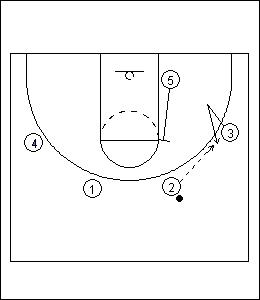
Players start in a 4 out and 1 in formation. Players One (1), Two (2), Three (3) & Four (4) are spread around the perimeter, Five starts in the ball-side low post.
Three (3) will v-cut to get open for a pass from Two (2).
If Three (3) is being overplayed by their defender, they should look for a back-door cut and pass from Two (2).
As Two (2) passes to Three (3), Five (5) should move up the lane to the high post area and be ready to set a back screen for Two (2).
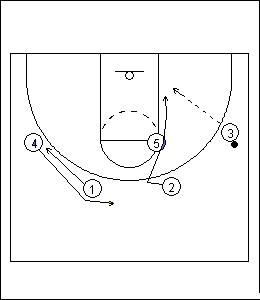
Two (2) passes to Three (3) and then uses Five’s (5) screen to cut to the basket. Two (2) must make a good v-cut to set up their defender for the screen, and then run their defender into the screener.
Two (2) should cut right down the lane looking for a return pass from Three (3).
As this is happening, One (1) and Four (4) will switch positions, or replace each other.
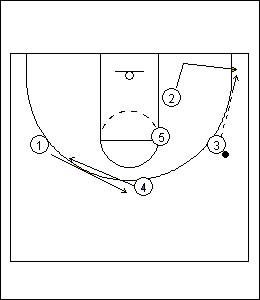
If the pass from Three (3) is not open, Two (2) should clear out to the ball-side corner.
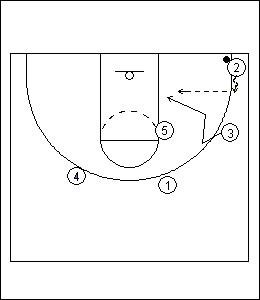
Three (3) will make a pass to Two (2) in the corner and then cut to the basket. This is the “give-and-go.”
It is important for Two (2) to dribble out of the corner, to avoid being trapped, and then look for the pass to Three (3).
As Three (3) passes to Two (2), One (1) and Four (4) will switch positions again. This simple action helps keep their defenders occupied and unable to sag into the middle for help defence.
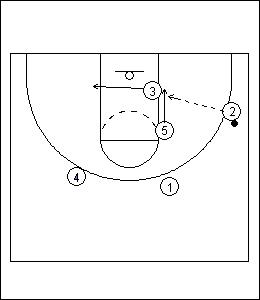
If the pass from Two (2) to Three (3) is not open, Three (3) should continue to the other side of the lane.
Five (5) will then slide down to the low post area looking for a pass from Two (2).
If Five (5) is open or can get good post position, Two (2) should make the pass.
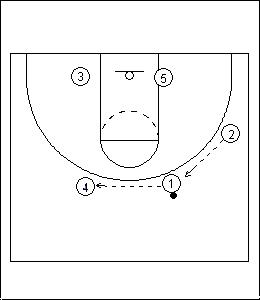
If the pass from Two (2) to Five (5) is not open, Two (2) will pass the ball out to One (1).
One (1) will then pass the ball to Four (4).
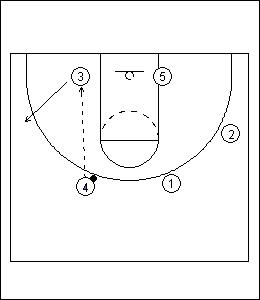
When Four (4) receives the pass from One (1), they should immediately look to Three (3) in the low post.
If Three (3) has good post position, Four (4) should pass the ball.
If Three (3) doesn’t get a pass from Four (4) in the low post, they should immediately cut out to the foul line extended area.
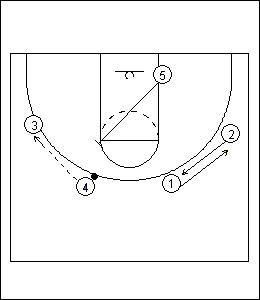
Four (4) will make a pass to Three (3) at the foul line extended.
Five (5) will come out to the high post area and be ready to set a back screen for Four (4).
You are now back at the beginning step of the play.






